Assistive Listening Devices
Do Assistive Listening Devices Work for Better Hearing?
Wondering if assistive listening devices truly work for better hearing? Discover the surprising truths and benefits that may change your perspective.
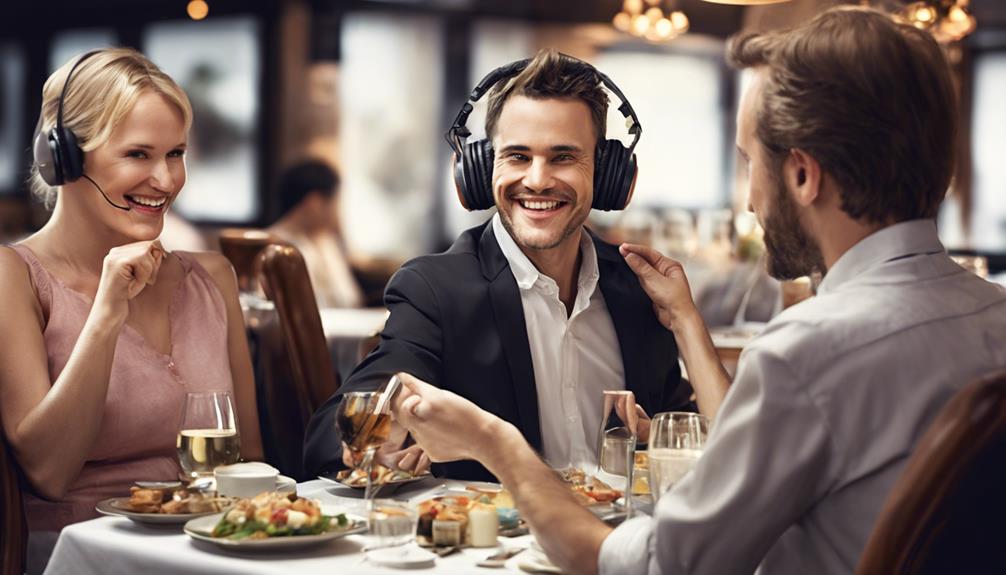
In discussions about the effectiveness of assistive listening devices, opinions vary significantly. Many attest to their capability to improve sound clarity, yet some doubt their genuine effect on auditory capabilities as a whole.
However, as we explore the various types of devices available and the benefits they offer, a clearer picture emerges.
So, do assistive listening devices truly work for better hearing, or is there more to the story than meets the eye?
Key Takeaways
- Assistive listening devices significantly improve speech understanding and reduce background noise for individuals with hearing loss.
- Various types such as FM systems and induction loops offer clarity and accessibility in different environments.
- Using listening devices enhances communication, psychological well-being, and active engagement in daily activities.
- Consider comfort, compatibility, maintenance, and costs when choosing and using assistive listening devices for optimal effectiveness.
Effectiveness of Assistive Listening Devices
Assistive listening devices have been proven to significantly enhance hearing capabilities, providing a notable 15-25 dB volume increase for individuals dealing with hearing loss. These devices, including telecoil-equipped hearing aids, cochlear implants, and Assistive Listening Systems (ALSs), play a crucial role in improving sound clarity and reducing background noise. By amplifying sound and minimizing distractions, assistive listening devices help individuals with hearing impairments overcome listening challenges in various settings like classrooms, theaters, and public spaces.
Research indicates that individuals using assistive listening devices can achieve similar speech understanding levels as those with normal hearing. These devices not only extend the effectiveness of traditional hearing aids and cochlear implants but also ensure accessibility for individuals with hearing impairments, aligning with ADA guidelines that recommend providing assistive listening devices at no cost in public places. By enhancing listening experiences and minimizing the impact of background noise, assistive listening devices are essential tools for individuals seeking to improve their hearing abilities and fully engage in everyday activities.
Types of Listening Devices
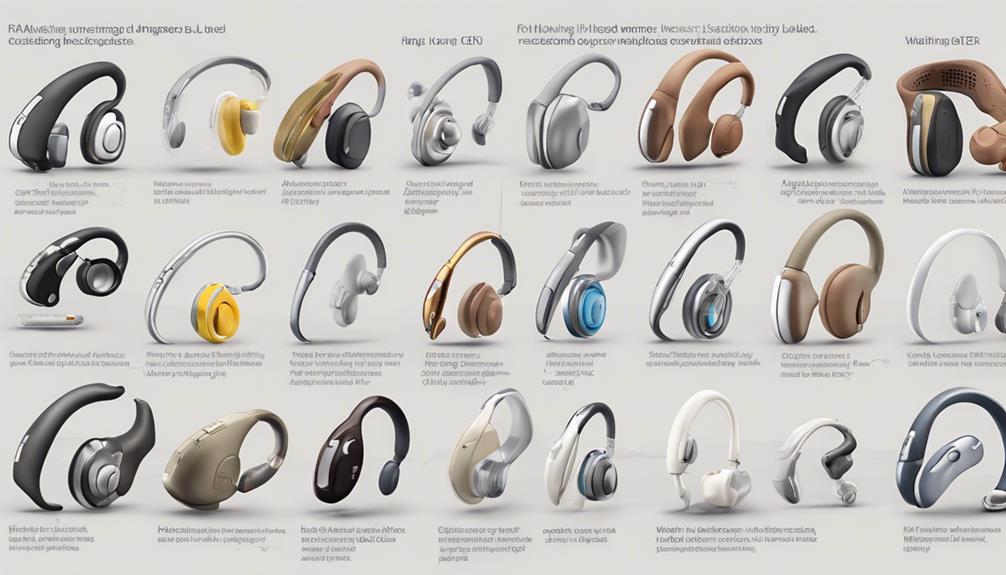
Among the various types of listening devices available for individuals with hearing loss, induction loops, FM systems, and infrared systems stand out as common and effective options. Induction loops work by transmitting sound electromagnetically to hearing aids equipped with telecoils, reducing background noise.
FM systems use radio signals to deliver sound directly to the listener, offering clarity in various environments. Infrared systems transmit audio signals through invisible light beams to receivers worn by users, ensuring privacy in settings like theaters or conference rooms.
Personal amplifiers and amplified phones are also valuable tools, amplifying sound and reducing interference. Additionally, IP relay services provide real-time captioning, enhancing communication for the hearing impaired.
These assistive listening devices play a crucial role in improving phone communication and daily activities for individuals with hearing loss, offering tailored solutions to meet diverse needs while enhancing overall quality of life.
Benefits of Using Listening Devices
Regularly using listening devices enhances speech understanding by amplifying sound directly into the ear, reducing background noise, and improving clarity for individuals with hearing loss. Hearing aids and other assistive listening devices play a crucial role in helping individuals with hearing difficulties engage more effectively in conversations and various auditory interactions. By reducing background noise, these devices enhance the overall listening experience, making speech clearer and easier to comprehend.
Moreover, the benefits extend beyond improved speech understanding. Assistive listening devices can also positively impact psychological well-being by alleviating feelings of anxiety and depression that may arise from struggling to hear and communicate effectively. Additionally, these devices support individuals in maintaining relationships and participating in daily activities by ensuring they can actively engage with their surroundings. For individuals with total hearing loss, assistive devices provide visual alerts or vibration alerts, enabling them to remain connected and informed in various environments.
Considerations for Device Users

When considering assistive listening devices, it's crucial to prioritize user comfort preferences to ensure prolonged use without discomfort.
Device compatibility issues need to be carefully evaluated to guarantee seamless integration into daily activities.
Additionally, maintenance and care requirements should be factored in to prolong the lifespan and effectiveness of the chosen device.
User Comfort Preferences
User comfort preferences are pivotal in determining the efficacy of assistive listening devices. Factors such as device fit, ease of use, and personal preferences play a significant role in user satisfaction. Customizable features like volume control and noise reduction contribute to the overall comfort of the user.
The choice between over-the-ear headphones and discreet in-ear devices can impact the comfort and experience of the individual. User feedback and device trials are essential in determining the most comfortable and effective assistive listening device for each person.
Understanding and catering to these preferences can lead to better outcomes and increased user satisfaction with the device. Ultimately, considering user comfort preferences is crucial in achieving optimal results with assistive listening devices.
Device Compatibility Issues
Optimal performance of assistive listening devices hinges on ensuring seamless compatibility with existing technology, necessitating careful consideration of the user's specific hearing aid or cochlear implant type. When addressing device compatibility, users should pay attention to several key factors:
- Hearing Aid Compatibility: Understanding the specific requirements of one's hearing aid model is crucial for selecting the right assistive listening device.
- Telecoil Capabilities: Leveraging the telecoil feature in hearing aids can enhance the effectiveness of hearing loop systems and other ALD technologies.
- Device Compatibility: Some ALDs may need additional accessories or adapters to connect with certain hearing devices, highlighting the importance of thorough research.
- Impact of Compatibility Issues: Compatibility issues can hinder the functionality of ALDs, underscoring the significance of informed decision-making when choosing assistive listening solutions.
Maintenance and Care
Considering the essential aspect of maintaining and caring for assistive listening devices, regular upkeep is imperative to ensure their longevity and optimal functionality.
To maintain optimal performance, it's crucial to check batteries and connections regularly. Cleaning the devices frequently helps prevent the buildup of dirt or debris that can affect sound quality.
Adhering to the manufacturer's guidelines for care and storage can significantly extend the lifespan of assistive listening devices. Proper handling and storage when not in use can prevent damage and ensure continued functionality.
Seeking professional assistance for maintenance or repairs is advisable to promptly address any issues that may arise and maintain the effectiveness of the devices.
Cost and Insurance Coverage
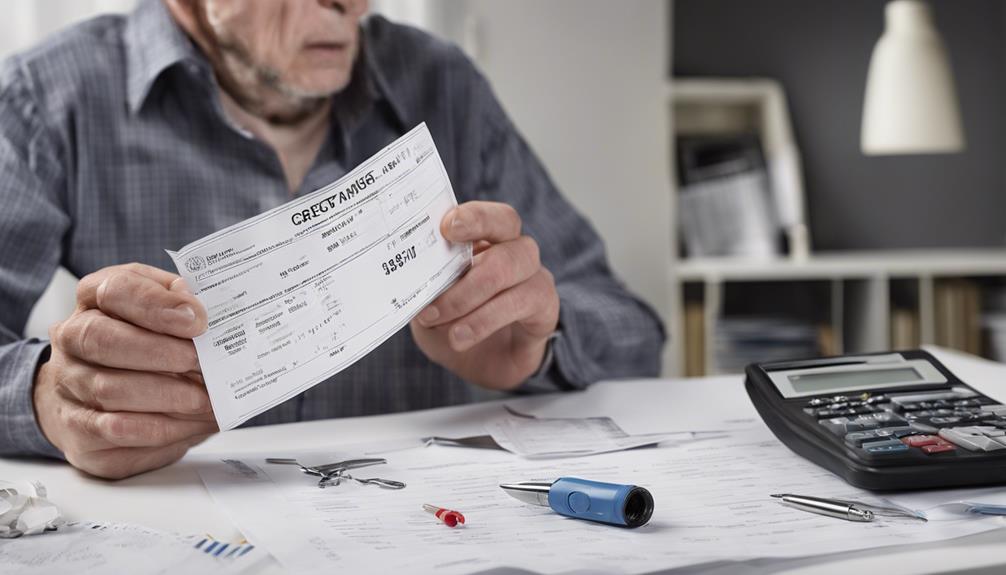
When considering the cost and insurance coverage of assistive listening devices, it's important to note that the price of these devices can vary significantly based on their features and type.
- Some ALDs, like personal amplifiers, can be as affordable as $50, while more specialized devices such as TV amplifiers may cost around $200.
- Insurance coverage for ALDs is generally limited, but certain devices may be covered under Medicare, Medicaid, or private insurance plans.
- Captioned Telephone Services offer free captioning for phone calls, aiding individuals with hearing loss who rely on speechreading.
- Federally funded programs like the Telecommunications Relay Services (TRS) provide financial assistance for acquiring assistive listening devices.
These options can make ALDs more financially accessible to those in need. Additionally, some states offer programs that provide financial aid or low-interest loans for the purchase of ALDs, further aiding individuals with hearing loss in obtaining the necessary devices for improved hearing.
Where to Purchase Listening Devices
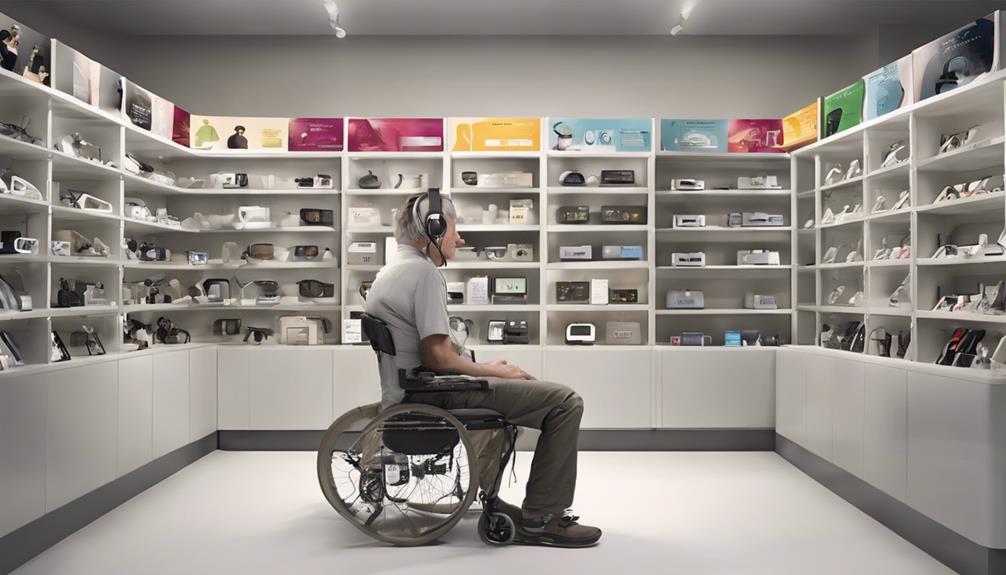
Assistive listening devices can be purchased from specialized retailers, online stores, audiologists, and hearing healthcare providers. These devices are also available over-the-counter without a prescription, making them easily accessible for individuals seeking solutions for their hearing needs. When considering a purchase, it's essential to explore potential insurance coverage options, as some plans, including Medicare, may help offset the cost depending on the policy and device type.
To ensure that you select the most suitable device, it's recommended to conduct thorough research, compare prices, evaluate features, and review customer feedback. Additionally, local hearing loss support groups or organizations can provide valuable resources and guidance on where to find appropriate listening devices. By leveraging these resources and taking the time to make an informed decision, individuals can enhance their hearing experience with the right assistive technology tailored to their specific needs.
User Testimonials and Reviews

Users' experiences with assistive listening devices often showcase remarkable improvements in hearing clarity and speech comprehension. Based on user testimonials and reviews, here are some key points highlighting the benefits of assistive listening devices:
- Reduced Background Noise:
Many users report a significant reduction in background noise, allowing them to focus better on conversations and important sounds.
- Enhanced Sound Quality:
Reviews frequently mention the improved sound quality experienced when using ALDs, making speech and audio crisper and clearer.
- Improved Communication:
Testimonials emphasize how assistive listening devices have enhanced communication abilities, leading to increased engagement in social interactions and daily activities.
- Ease of Use and Compatibility:
Users express satisfaction with the user-friendly nature and compatibility of assistive listening devices, making them seamless additions to their daily routines.
Frequently Asked Questions
Which Electrical Device Helps to Improve Hearing Ability?
Electric devices with telecoils improve hearing ability by wirelessly connecting to hearing loop systems. These systems create electromagnetic fields that enhance sound transmission directly to compatible devices.
The telecoil technology within these devices offers a clearer and personalized listening experience for those with hearing loss.
Additionally, telecoil accessories can be added to cochlear implants, enabling direct connection to hearing loops, thus enhancing hearing ability in various environments.
What Are the Disadvantages of Hearing Devices?
Disadvantages of hearing devices include:
- The high cost
- Regular maintenance like battery changes
- Dependency on batteries for power
- Potential signal interference affecting sound quality
- A learning curve for effective use
These factors can pose challenges for individuals seeking better hearing. It's crucial to weigh these drawbacks against the benefits before investing in a hearing device.
What Assistive Technology Is Used for Severe Hearing Loss?
When facing severe hearing loss, various assistive technologies can be employed. Cochlear implants, bone conduction implants, and middle ear implants are common choices.
Direct audio input (DAI) systems facilitate direct connection to audio sources for improved clarity. Implantable devices like Vibrant Soundbridge and Esteem offer enhanced sound quality and speech comprehension.
These technologies directly stimulate auditory nerves, transmit sound vibrations through bone, or amplify vibrations in the middle ear, aiding those with severe hearing loss.
Which Device Can Be Used to Improve Hearing?
We find that personal amplifiers, like the Pocketalker, can greatly enhance hearing by amplifying sound for those with hearing loss. These devices offer clearer and louder audio in a variety of settings, providing a significant improvement in hearing quality.
Conclusion
In conclusion, assistive listening devices have revolutionized the way individuals with hearing impairments experience the world around them. They not only enhance sound clarity and reduce background noise, but also provide a significant increase in volume without distortion.
From hearing loops to personal amplifiers, these devices have proven to be effective in various settings. So, whether it's a family gathering or a crowded theater, assistive listening devices work wonders for better hearing.
Assistive Listening Devices
What Wireless Assistive Listening Devices Are Best for Seniors?
A world of enhanced sound awaits seniors with top-notch wireless assistive listening devices – find out which devices offer comfort and cutting-edge technology.
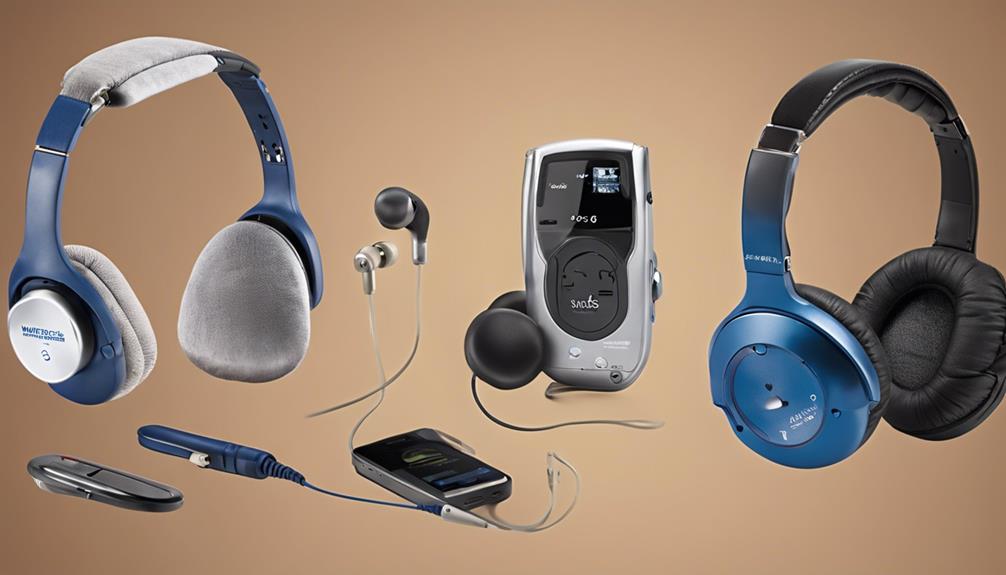
In the world of assistive listening devices for the elderly, imagine an environment where pristine sound effortlessly elevates everyday moments.
Curious to know which devices stand out for their ease of use and reliability? Stay tuned as we explore a selection of top-notch wireless assistive listening devices tailored to meet the unique needs of seniors, offering a blend of cutting-edge technology and comfort.
Key Takeaways
- Modern hearing aids with noise reduction and Bluetooth offer convenience and clear sound for seniors.
- Lightweight personal amplification devices like Bellman & Symfon Mino enhance conversations for mild to moderate hearing loss.
- Wireless solutions such as neckloop systems and Bluetooth devices provide hands-free hearing enhancement.
- User-friendly designs with high-fidelity audio and portable features cater to seniors' needs for comfortable listening.
Hearing Aids for Seniors
In our exploration of hearing aids for seniors, it becomes evident that these devices play a crucial role in enhancing the quality of life for older individuals experiencing age-related hearing loss. Modern hearing aids offer a range of styles, including behind-the-ear (BTE), in-the-ear (ITE), and completely-in-the-canal (CIC), catering to diverse preferences and needs.
Seniors benefit from advanced features like noise reduction, which helps in filtering out unwanted background sounds, and feedback cancellation, which minimizes annoying whistling noises. Bluetooth connectivity in hearing aids allows seamless integration with smartphones and other devices, enabling users to stream audio directly to their hearing aids.
Rechargeable hearing aid models have gained popularity among seniors due to their convenience and cost-effectiveness compared to traditional disposable batteries. Additionally, Telecoil technology empowers seniors to connect to assistive listening systems in public spaces, ensuring clearer sound quality and improved communication.
These innovative features collectively contribute to making hearing aids a vital tool for seniors seeking improved hearing and overall well-being.
Personal Amplifiers for Elderly

Enhancing sound clarity and improving communication for seniors with mild to moderate hearing loss, personal amplifiers such as the Bellman & Symfon Mino are discreet, lightweight devices that offer adjustable volume and tone control. These devices are popular among seniors for one-on-one conversations due to their ability to amplify speech and reduce background noise, making communication easier in various settings.
The Bellman & Symfon Mino Personal Amplifier specifically caters to the specific hearing needs of seniors by providing customizable volume and tone settings. Seniors can benefit significantly from using personal amplifiers as they allow for active participation in social interactions and ensure clearer audio in everyday situations.
- Personal amplifiers like the Bellman & Symfon Mino enhance sound clarity in one-on-one conversations.
- These devices are discreet, lightweight, and ideal for seniors with mild to moderate hearing loss.
- Personal amplifiers amplify speech and reduce background noise, improving communication for elderly individuals.
- The Bellman & Symfon Mino Personal Amplifier offers adjustable volume and tone control to cater to specific hearing needs.
Neckloop Telecoil Systems
Neckloop telecoil systems, utilizing advanced telecoil technology, seamlessly connect wirelessly to hearing aids or cochlear implants for enhanced audio reception. These systems operate by generating an electromagnetic field that directly transmits audio signals to the user's hearing device, ensuring a clear and personalized listening experience. Compatible with most hearing aids and cochlear implants equipped with telecoils, neckloop systems are discreet and convenient for seniors seeking assistive listening solutions.
Ideal for various environments, these systems offer a hands-free and comfortable way for seniors to improve their hearing without the need for bulky equipment. Seniors can benefit from the enhanced accessibility provided by neckloop telecoil systems, allowing them to engage more effectively in conversations and activities while maintaining discretion and ease of use.
With their seamless integration with hearing aids and cochlear implants, neckloop telecoil systems represent a valuable tool for seniors looking to enhance their overall hearing quality.
Bluetooth Hearing Devices
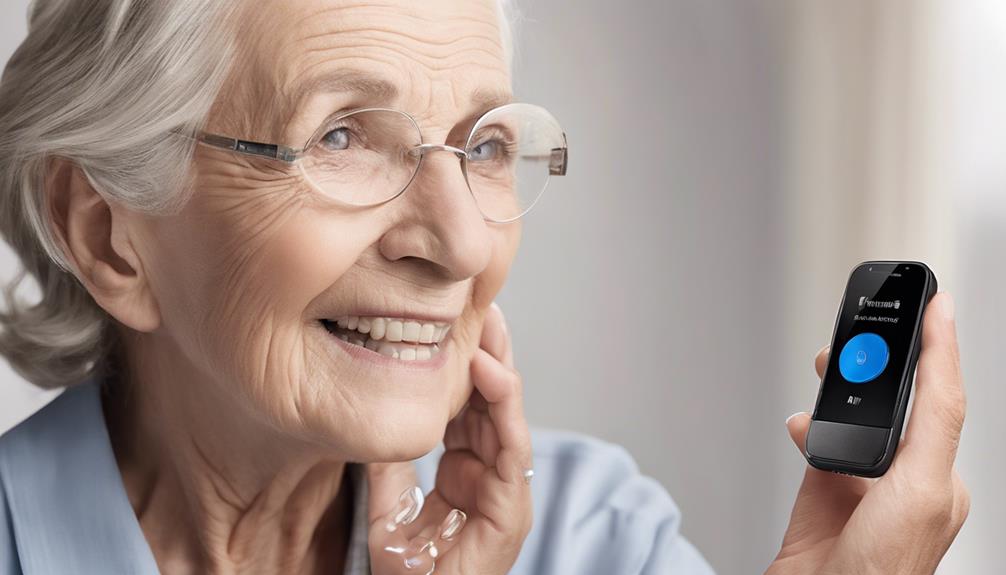
Bluetooth hearing devices revolutionize audio connectivity for seniors by offering seamless wireless streaming to smartphones, TVs, and other devices. These devices leverage Bluetooth technology to provide personalized sound amplification, enhancing the listening experience for seniors with hearing loss.
Here are some key features of Bluetooth hearing devices:
- Adjustable Settings: Many Bluetooth hearing devices come with adjustable settings for volume, tone, and sound preferences, allowing seniors to customize their listening experience to suit their individual needs.
- Improved Sound Quality: Bluetooth technology enables seniors to enjoy improved sound quality while answering phone calls, listening to music, or watching TV, providing a more convenient and enjoyable audio experience.
- Rechargeable Batteries: Some Bluetooth hearing devices are equipped with rechargeable batteries, offering long-lasting usage and eliminating the need for frequent battery changes, adding to the convenience for seniors.
- Versatile Use: These devices are compatible with various audio sources, making them versatile for different situations and environments, ensuring seniors can benefit from enhanced audio streaming across different devices.
TV Listening Headphones
With the convenience and personalization Bluetooth hearing devices offer, transitioning to TV listening headphones further enhances the audio experience for seniors seeking a tailored TV-watching solution. TV listening headphones provide wireless convenience for seniors, allowing them to enjoy TV without disturbing others. Options like the Sennheiser SET840-S offer clear audio transmission with customizable settings, catering to seniors with varying degrees of hearing loss.
These wireless TV speakers amplify sound directly to the ears, aiding seniors in hearing dialogue and sound effects more clearly. Adjustable volume levels in some TV headphones accommodate different levels of hearing impairment, ensuring a personalized experience. Additionally, certain models come equipped with built-in rechargeable batteries, extending their use without the hassle of frequent battery replacements.
Seniors looking for a customizable, wireless solution to enhance their TV audio experience can benefit greatly from investing in TV listening headphones designed to meet their specific needs.
Wireless Hearing Amplifiers

Wireless hearing amplifiers discreetly enhance sound for seniors by amplifying surrounding sounds while reducing background noise, ideal for improving hearing in various settings. When considering wireless hearing amplifiers for seniors, it's essential to understand their features and benefits:
- Personal Sound Amplification: These devices provide personalized sound amplification tailored to the user's hearing needs.
- Wireless Amplified TV Listening: Seniors can enjoy watching TV with enhanced sound quality and clarity through wireless connectivity.
- Background Noise Reduction: The technology in wireless hearing amplifiers helps minimize background noise, allowing seniors to focus on conversations or other audio content.
- Assistive Listening Devices: Wireless hearing amplifiers serve as valuable assistive devices for seniors, aiding in everyday communication and enhancing their overall hearing experience.
Infrared TV Listening Systems

Infrared TV listening systems excel in their range of coverage and sound quality, providing seniors with a reliable solution for enhanced TV audio.
The infrared technology ensures a clear signal without interference, making it ideal for individuals with hearing loss.
With easy setup and user-friendly operation, brands like Sennheiser and Serene Innovations offer practical options for seniors seeking improved TV listening experiences.
Range of Coverage
For optimal performance, infrared TV listening systems rely on a direct line of sight between the transmitter and receiver, ensuring clear audio within a range of up to 33 feet. These systems operate on line-of-sight technology, requiring an unobstructed path for the signal to transmit effectively.
Here are key points about the range of coverage for infrared TV listening systems:
- The infrared signal used by these devices is secure and won't interfere with other electronic devices or neighboring systems.
- Ideal for seniors seeking a more private listening experience, as the signal doesn't pass through walls or ceilings.
- Seniors looking for a simple plug-and-play solution to enhance their TV listening experience at home find infrared systems reliable.
- The up to 33 feet range offers clear audio for seniors within the immediate vicinity of the transmitter.
Sound Quality
As we explore the sound quality of infrared TV listening systems, it becomes apparent that these devices excel in providing seniors with a high-fidelity audio experience tailored to their hearing needs. Infrared TV listening systems offer high-quality sound transmission, delivering clear stereo sound without interference from background noise.
This technology ensures a secure signal directly to compatible headphones or receivers, allowing seniors to enjoy TV shows, movies, and music with enhanced clarity and volume. For seniors seeking a reliable and easy-to-use wireless solution to improve TV audio without the need for hearing aids, Infrared TV listening systems stand out as an excellent choice.
These systems prioritize sound quality, making the viewing experience more enjoyable and accessible for individuals with hearing loss.
Frequently Asked Questions
What Is the Most Commonly Used Assistive Listening Device?
The most commonly used assistive listening device is the personal sound amplifier, like the Sound World Solutions HD75. It helps amplify sounds and reduce background noise for seniors.
Personal amplifiers, such as the Bellman & Symfon Mino Personal Amplifier, are also popular for enhancing sound clarity during conversations and activities.
Wireless TV listening devices, like the Sennheiser SET840-S Loop System, improve TV sound without disturbing others, making them essential tools for seniors.
What Is the Easiest Hearing Aid to Use for Seniors?
When it comes to finding the easiest hearing aid for seniors, the Bellman & Symfon Mino Personal Amplifier stands out. Its user-friendly design, simple controls, clear sound amplification, and reduced background noise make it ideal for seniors with hearing difficulties.
This hearing aid offers a comfortable fit, easy-to-adjust volume settings, discreet portability, long battery life, and intuitive operation. Overall, the Bellman & Symfon Mino Personal Amplifier is a top choice for seniors seeking an easy-to-use solution.
What Is the Difference Between an Assistive Listening Device and a Hearing Aid?
When comparing an assistive listening device to a hearing aid, it's essential to understand that while both technologies aim to improve hearing, they serve different purposes.
An assistive listening device enhances sound in specific environments for anyone needing assistance, while a hearing aid is a medical device tailored to an individual's hearing loss.
This distinction highlights the importance of selecting the right solution based on one's unique hearing needs.
What Could an Older Person Use to Hear Clearly?
We might think that older individuals could benefit from various tools to hear clearly. These might include:
- Wireless headphones for TV
- Sound amplifiers
- Amplified telephones
- Alerting devices with flashing lights
- Hearing assistive devices designed for mild to moderate hearing loss
Each of these tools has its unique features that cater to the specific needs of seniors looking to enhance their auditory experiences.
Conclusion
In conclusion, when it comes to choosing the best wireless assistive listening devices for seniors, it's important to consider options that not only enhance sound clarity but also provide comfort and convenience.
These devices act as a beacon of hope, guiding seniors towards a world of improved hearing and communication.
By investing in the right wireless assistive listening device, seniors can enjoy a renewed sense of connection and engagement in their daily lives.
Assistive Listening Devices
What Assistive Listening Devices Are Available in Movie Theaters?
Get ready to uncover the hidden technology enhancing the cinematic experience for those with hearing impairments in movie theaters – the answer may surprise you!
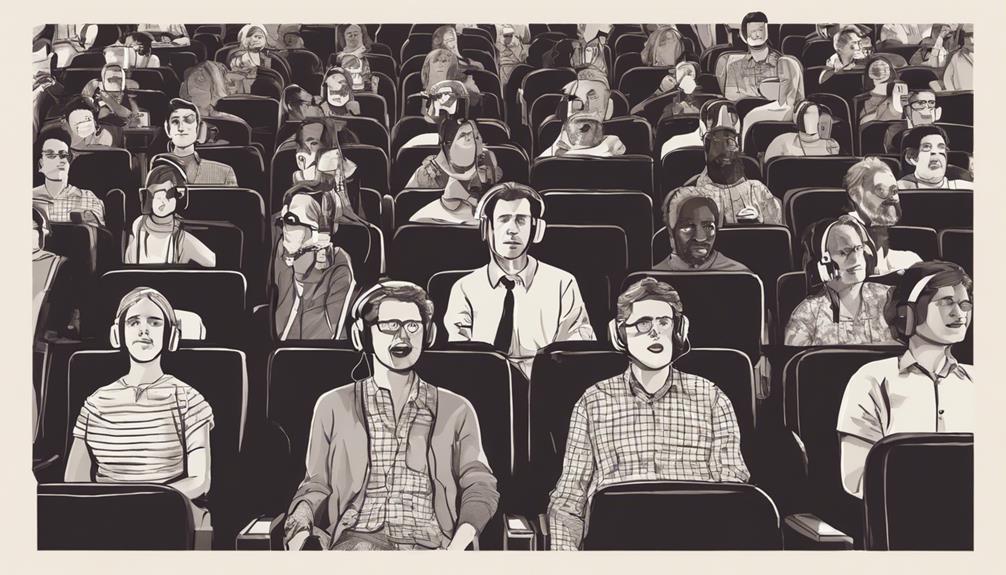
As we find our places in the cinema seats, the excitement of the movie screen awakening is tangible.
But have you ever wondered about the invisible technologies that can transform the auditory experience for those with hearing impairments?
Let's explore the array of assistive listening devices available in movie theaters that seamlessly blend into the cinematic magic, ensuring a more inclusive and immersive viewing experience for all.
Key Takeaways
- Infrared, loop, FM systems offer clear sound for hearing-impaired individuals.
- Loop systems transmit audio directly to t-coils in hearing aids.
- Captioning devices provide text display for enhanced accessibility.
- Induction loops and t-coil compatibility improve sound accessibility in theaters.
Infrared Systems
In movie theaters, infrared systems utilize infrared light to transmit audio signals to assistive listening devices, ensuring clear sound for individuals with hearing loss. These systems are a crucial component of theaters aiming to provide an inclusive experience for all patrons. By using infrared technology, theaters can offer a direct and private transmission of audio to compatible receivers, ensuring that users with hearing impairments can enjoy movies with enhanced sound quality and clarity.
The beauty of infrared systems lies in their ability to cater to the specific needs of individuals with hearing loss. Unlike traditional sound systems that may not adequately support those with auditory challenges, infrared systems guarantee a personalized listening experience. By leveraging these systems, theaters can create a more accommodating environment where every moviegoer can immerse themselves fully in the audio-visual spectacle without missing out on the nuances of the soundtracks.
Loop Systems
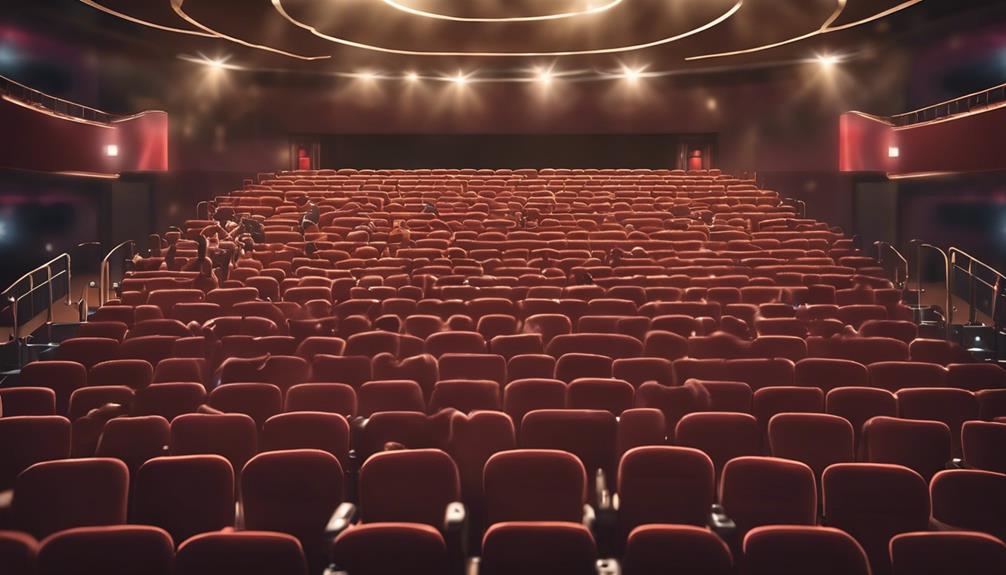
Loop systems in movie theaters are designed to transmit audio directly to hearing aid t-coils, offering a personalized listening experience for individuals with hearing loss. These systems require t-coils to be activated by an audiologist to ensure compatibility with loop technology.
Neck loops play a crucial role in connecting t-coils to public sound systems, enhancing the overall sound quality for users.
Loop System Basics
To effectively utilize loop systems in movie theaters, individuals with hearing aids must have their t-coils enabled by an audiologist. Here are some key basics to understand about loop systems:
- Loop systems in theaters transmit audio directly to enabled t-coils in hearing aids.
- T-coils need to be enabled by an audiologist for loop systems to function effectively.
- Neck loops serve as connectors between t-coil hearing aids and public sound systems in theaters.
- AMC theaters provide receivers and neck loops for hearing aid users with active t-coils, while Cinemark theaters offer AudiLinks model 2 for t-coil users to connect to loop systems.
Loop System Benefits
Utilizing loop systems in theaters equipped with assistive listening devices enhances the auditory experience for individuals with hearing aids by transmitting audio directly to enabled t-coils for optimal sound clarity. T-coils, once enabled by an audiologist, allow users to connect to loop systems seamlessly. This direct transmission reduces background noise, providing a focused sound experience for those with hearing loss.
Cinemark theaters offer the AudiLinks model 2 to enhance the movie-watching experience for t-coil users, while AMC theaters provide receivers and neck loops for active t-coil users to access loop systems effortlessly. The benefits of loop systems extend beyond improved sound quality, offering a more inclusive and enjoyable cinematic experience for individuals with hearing impairments.
Loop System Installation
Moving from the benefits of loop systems in movie theaters, the implementation of loop system installations involves strategically placing electromagnetic wires around the theater space for direct sound transmission to hearing aids with t-coils. This process ensures that individuals with hearing aids equipped with t-coils can receive clear audio signals without background noise interference.
- Precise Placement: Electromagnetic wires are strategically positioned around the theater perimeter for optimal signal transmission.
- T-Coil Activation: Audiologists must activate the t-coils in hearing aids to enable them to pick up signals from the loop systems.
- Growing Popularity: Loop systems, utilizing electromagnetic technology, are becoming more prevalent in the U.S. to enhance hearing accessibility in public venues.
- Seamless Experience: Movie theaters with loop systems offer a discreet and seamless hearing experience for patrons with hearing aids.
Captioning Devices
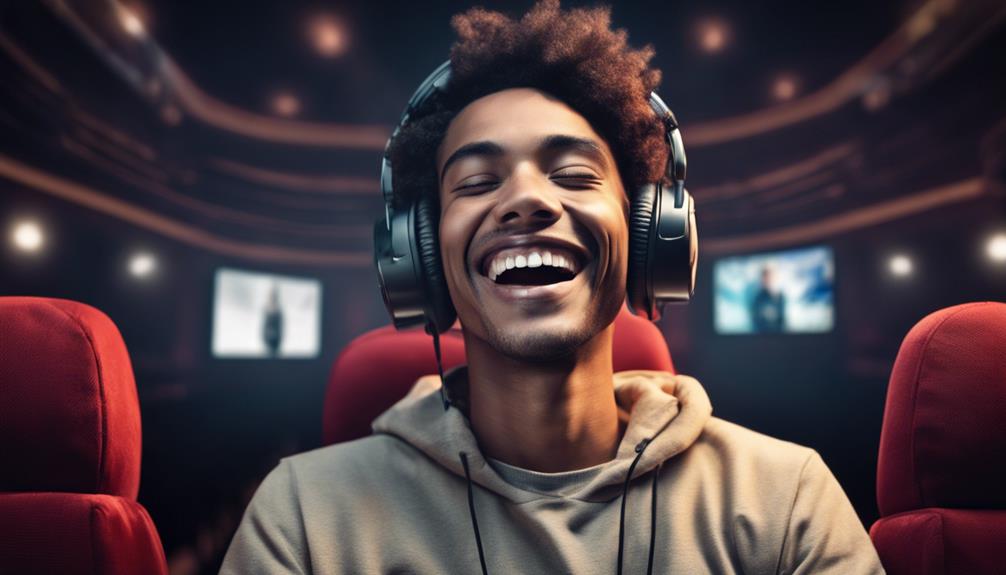
Captioning devices play a crucial role in enhancing the movie-watching experience for individuals with hearing impairments. Understanding the types of captioning available, how captioning technology works, and the benefits it provides can shed light on the importance of these devices in movie theaters.
Types of Captioning
When it comes to enhancing accessibility for individuals with hearing loss in movie theaters, various types of captioning devices are available to provide personalized caption viewing experiences.
- Open captioning displays text on the screen for all viewers in the theater.
- Closed captioning requires a personal device to transmit captions privately to the user.
- Open caption screenings are rare but can be arranged for specific requests at certain theaters.
- Different theater chains offer various closed captioning devices like CaptiView or Sony Access eyeglasses.
Closed captioning and open captioning options aim to make movies more accessible for individuals with hearing loss, ensuring that everyone can enjoy the film with subtitles tailored to their needs.
How Captioning Works
Using advanced technology, captioning devices in movie theaters provide personalized caption viewing experiences for individuals with hearing loss. Open captioning displays text directly on the screen, visible to all moviegoers.
In contrast, closed captioning requires the use of personal devices, such as CaptiView devices offered by AMC Theaters. These devices enable viewers to access captions individually, enhancing the movie-watching experience for those who are deaf or hard of hearing.
Regal Theaters also offer Sony Access eyeglasses for open caption screenings, providing another option for patrons. Cinemark likely provides similar CaptiView closed captioning devices for personalized use, ensuring that individuals with hearing impairments can fully enjoy the cinematic experience through assistive technology like Captioning Devices.
Benefits of Captioning
We can appreciate the significant advantages that captioning devices offer to individuals with hearing loss in enhancing their movie-watching experience.
- Open captioning provides a universally accessible experience by displaying text on the screen for all viewers.
- Closed captioning offers a discreet option, requiring a personal device to transmit captions privately.
- Regal Theaters enhance the viewing experience through Sony Access eyeglasses for open captions.
- AMC Theaters cater to a range of hearing needs with amplified headsets and CaptiView devices for closed captions.
These options ensure that individuals with hearing loss can enjoy movies with increased accessibility and a personalized viewing experience.
FM Systems
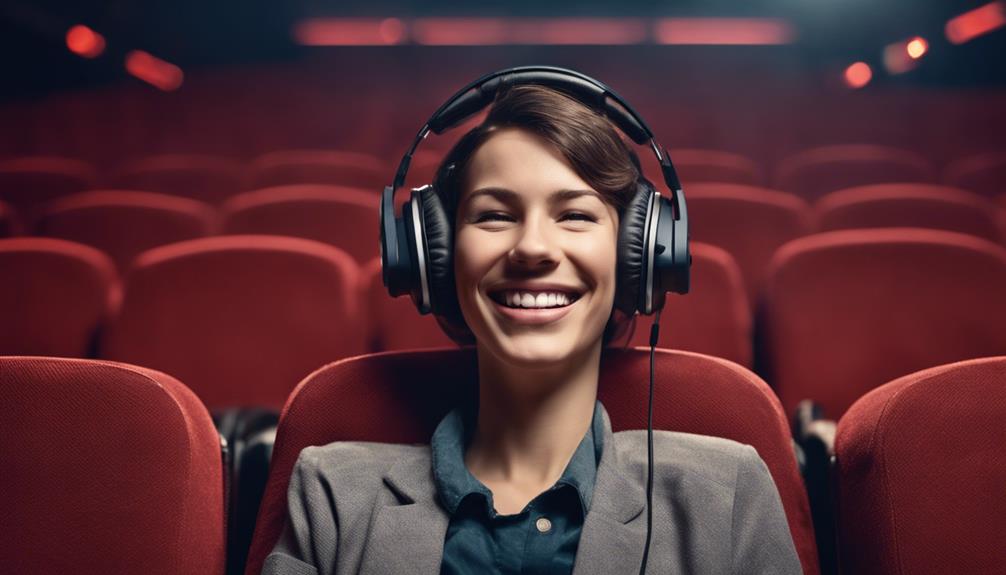
FM Systems in movie theaters employ radio signals to directly transmit audio to personal receivers, enhancing sound clarity and reducing background noise for individuals with hearing loss. These systems are particularly advantageous for those who struggle to discern dialogue in movies due to hearing impairments.
By tuning into the radio signals, users can enjoy a more immersive cinematic experience without being hindered by external noise distractions. The ability to adjust the volume of the FM System allows individuals to personalize their listening experience according to their specific hearing needs.
Movie theaters equipped with FM Systems prioritize inclusivity, providing patrons with hearing impairments the opportunity to fully engage with the audio aspects of the film. Overall, FM Systems play a crucial role in making movie theaters more accessible and accommodating for individuals with hearing challenges, ensuring that everyone can enjoy the magic of cinema without limitations.
Induction Loops
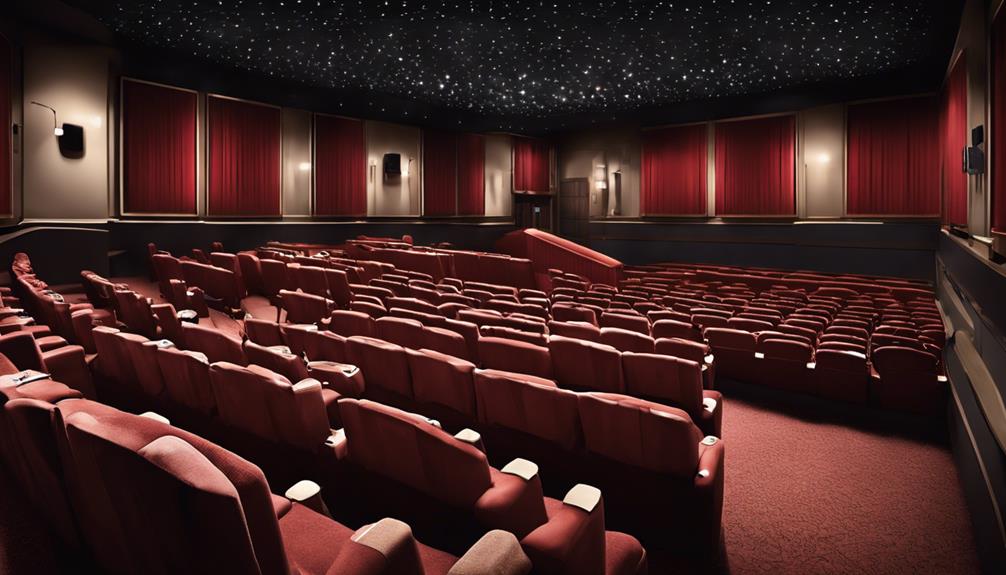
Transitioning from FM Systems, another widely utilized assistive listening option in movie theaters is the use of Induction Loops, which transmit sound directly to hearing aids equipped with T-coils. Induction loops function by creating a magnetic field that's picked up by the T-coil in compatible hearing aids, converting it into sound.
Here are some key points about induction loops:
- Direct Transmission: Induction loops directly transmit audio signals to hearing aids with T-coils enabled, eliminating the need for separate receivers.
- Audiologist Activation: T-coils need to be activated by an audiologist for individuals to benefit from induction loop systems effectively.
- AMC Theater Offerings: AMC theaters provide receivers and neckloops for patrons to connect to induction loops with their hearing aids.
- Cinemark Options: Some Cinemark theaters offer the AudiLinks model 2, catering to individuals with T-coils for an enhanced auditory experience.
Induction loops are a prevalent choice among assistive listening devices in movie theaters, providing accessibility and inclusivity for individuals with hearing impairments.
Hearing Aid Compatibility

Utilizing neck loops or receivers, hearing aid users can seamlessly connect to movie theater assistive listening systems, enhancing their auditory experience. T-coil enabled hearing aids, commonly found in modern hearing aids, are specifically designed to work with loop systems present in many movie theaters. Major theater chains like AMC and Cinemark offer devices catered to t-coil users, allowing them to optimize their movie-watching experience.
Neck loops serve as a crucial accessory in this setup, transmitting audio signals from the movie theater systems directly to the t-coil enabled hearing aids worn by the users. For those actively using t-coil technology, requesting receivers and neck loops at participating movie theaters can significantly improve sound accessibility during movie screenings. By ensuring compatibility between hearing aids and theater systems through these devices, hearing aid users can enjoy a more inclusive and immersive cinematic experience, enhancing their overall enjoyment of films.
Mobile Apps
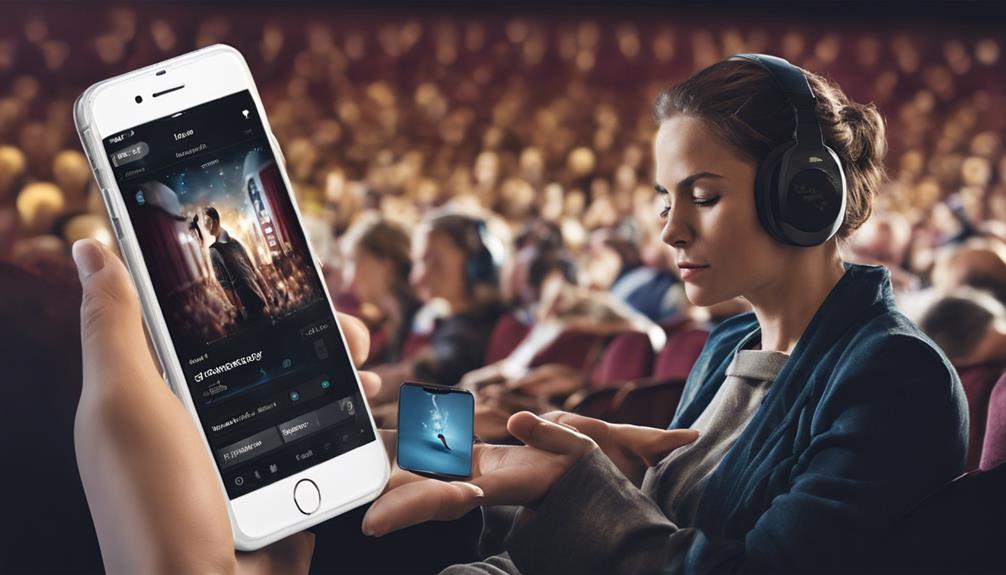
Mobile apps like the MobileConnect App offer users with hearing loss a convenient way to connect headphones to their smartphones for improved audio quality during movie screenings. These apps provide a personalized listening experience by allowing users to tailor volume levels to suit their hearing preferences. With mobile apps, individuals seeking better sound clarity in theaters can enjoy enhanced accessibility features such as receiving captions or audio descriptions directly to their devices.
Here are four key benefits of using mobile apps for improved audio quality during movie screenings:
- Enhanced Audio Quality: Mobile apps like the MobileConnect App ensure users experience improved sound quality through their headphones connected to smartphones.
- Personalized Listening Experience: These apps allow users to customize volume levels, providing a tailored audio experience based on individual hearing needs.
- Convenience and Flexibility: Mobile apps offer convenience and flexibility, allowing users to enjoy movies with better sound clarity anytime, anywhere.
- Accessibility Features: Users can benefit from accessibility features such as receiving captions or audio descriptions on their smartphones, enhancing their movie-watching experience.
Frequently Asked Questions
What Is Assistive Listening Devices in Movie Theaters?
Assistive listening devices in movie theaters enhance sound for patrons with hearing loss. They include FM systems, infrared systems, and personal amplification systems. These devices meet legal requirements and improve sound clarity and volume control.
They aim to reduce background noise interference and enhance dialogue comprehension. Overall, assistive listening devices increase accessibility and inclusivity for all moviegoers.
What Audio Equipment Do Movie Theaters Use?
When it comes to movie theaters and their audio equipment, a range of sophisticated systems may be in play. These include Induction Loop, Infrared, FM, and Bluetooth-enabled devices, each catering to different hearing needs.
These technologies help create an immersive cinematic experience for all patrons. The diverse array of equipment ensures that everyone can enjoy crystal-clear sound and feel truly connected to the audiovisual spectacle on the big screen.
What Is Assisted Listening Device at Cinemark?
At Cinemark theaters, the AudiLinks model 2 is provided as an assistive listening device for t-coil users. Specifically designed to support t-coil users, it enhances access to audio systems.
Neck loops are available for connection to the AudiLinks model 2. The t-coil symbol is displayed on Cinemark's website to indicate loop system availability.
All Cinemark theaters are equipped with loop systems to improve the movie-watching experience for t-coil users.
How Can I Hear Better at a Movie Theater?
To hear better at a movie theater, we should explore various assistive listening devices provided by theaters. These devices can enhance sound clarity and dialogue comprehension.
Adjusting volume settings on assistive listening devices can significantly improve our movie-watching experience.
Additionally, induction loop systems and open caption screenings are available in select theaters for improved listening access.
Researching theater websites for specific options can help us choose the best device for our needs.
Conclusion
In conclusion, movie theaters offer a range of assistive listening devices such as infrared systems, loop systems, captioning devices, FM systems, and more to enhance the movie-watching experience for individuals with hearing loss.
These technologies ensure that everyone can enjoy the latest films with clear audio and accessibility.
So next time you head to the movies, don't forget to take advantage of these modern marvels to truly 'hear' the magic on screen.
Assistive Listening Devices
What Are Assistive Listening Devices and How Do They Help?
Nurture your understanding of how Assistive Listening Devices revolutionize communication for individuals with hearing loss.

Were you aware that more than 48 million people in the United States have reported experiencing varying levels of hearing impairment?
Assistive listening devices (ALDs) play a crucial role in enhancing communication for individuals facing these challenges.
From small amplifiers to advanced wireless systems, ALDs help bridge the gap between sound and perception.
Let's explore the world of ALDs and how they contribute to improving the quality of life for those with hearing impairments.
Key Takeaways
- ALDs like hearing loops and FM systems enhance sound reception for individuals with hearing impairments.
- Telecoils and Bluetooth systems improve audio clarity and connectivity with telecommunication devices.
- Hardwired and wireless ALDs offer portability and tailored amplification options in various settings.
- Personalized listening experiences through ALDs promote independence and effective communication for users.
Types of ALDs
When exploring the various types of ALDs available, it becomes evident that each system offers unique features and benefits catered to specific listening environments and needs. ALDs encompass a range of technologies designed to enhance sound perception for individuals with hearing impairments.
Telecoil-equipped hearing aids are a common type that can connect directly to hearing loops, which are systems utilizing magnetic fields to transmit audio signals effectively in various settings.
FM systems operate wirelessly through radio waves, making them suitable for group events like meetings or classrooms, both indoors and outdoors. Infrared Systems use light beams to transmit sound, ensuring privacy and are ideal for places like churches or theaters.
Personal Amplified Systems are portable devices that provide individual amplification for one-on-one conversations or TV listening. Bluetooth Systems, compatible with Bluetooth-enabled hearing aids, offer versatility for indoor and outdoor use by transmitting sound via Wi-Fi technology.
Each of these ALDs serves a distinct purpose in improving auditory experiences for those with hearing challenges.
Benefits of ALDs

Exploring the benefits of ALDs sheds light on the significant advantages these devices offer individuals with hearing impairments, enhancing their communication experiences and breaking down barriers effectively.
ALDs play a crucial role in improving the reception of telecommunication and media signals for individuals with hearing loss, ensuring they don't miss important information. These devices are particularly beneficial for hard of hearing individuals, as research suggests a 15-25 dB volume increase is essential for effective communication.
Furthermore, ALDs work synergistically with hearing aids and cochlear implants, extending their effectiveness and providing additional support in challenging listening environments. Personal ALDs are tailored to increase the loudness of specific sounds, aiding individuals in adverse listening conditions where background noise or distance from the sound source may hinder comprehension.
Hardwired Devices
In the realm of assistive listening devices, hardwired options stand out for their use of cords in sound transmission, offering affordability and portability in short-distance settings. These devices excel in providing temporary amplification, making them ideal for situations like hospitals or cars where simplicity and ease of use are key.
The cord length limitations of hardwired ALDs, however, restrict mobility and seating arrangements, rendering them less suitable for larger venues such as classrooms or tour groups.
Despite these limitations, hardwired devices are incredibly effective in places like restaurants, where listener-to-speaker distances are short. By enhancing sound clarity and volume for individuals with hearing loss, they improve communication in everyday scenarios.
It's important to note that hardwired ALDs aren't typically recommended for settings requiring greater mobility or where longer cord lengths may hinder user movement. Their simplicity and affordability make them a practical choice for short-distance settings where temporary amplification is needed.
Wireless Devices

Wireless assistive listening devices offer users numerous benefits, including enhanced portability and flexibility in usage. These devices come in various types and offer different connectivity options, catering to diverse user preferences and needs.
Understanding the benefits, types, and connectivity options of wireless devices is crucial for individuals seeking improved auditory assistance.
Benefits of Wireless
When considering assistive listening devices, the advantages of wireless technology become apparent in their ability to enhance user mobility and connectivity. Wireless ALDs utilize various transmission methods such as FM radio waves, infrared light, or electromagnetic energy. This versatility offers users portability based on signal strength and device range, granting increased flexibility. However, the effectiveness of these devices can be influenced by the security of the signal and the line of sight between the transmitter and receiver. Here is a table highlighting the benefits of wireless ALDs:
| Benefits | Description |
|---|---|
| Enhanced Mobility | Allows users to move freely without being tethered by cords |
| Seamless Connectivity | Provides continuous and stable connection between the transmitter and receiver |
| Versatile Options | Offers different transmission methods to suit various environments |
Types of Devices
Considering the diverse applications of wireless technology in assistive listening devices, exploring the various types of devices available can provide valuable insights into optimizing user experience and accessibility.
- FM Radio Waves: Utilized for long-range transmissions, FM radio waves are popular for outdoor events and large venues due to their ability to cover extensive distances.
- Infrared Light: Ideal for short-range communication in settings like classrooms or meeting rooms, infrared light ensures secure and interference-free signal transmission.
- Electromagnetic Energy: Offering a balance between range and security, electromagnetic energy is commonly used in environments where a moderate coverage area is needed.
- Transmitter and Receiver: These components work in tandem to ensure the efficient transmission of sound from the source to the listener, enhancing the overall listening experience.
Connectivity Options
Exploring the diverse connectivity options in assistive listening devices opens up a world of possibilities for seamless and enhanced audio experiences. Wireless devices utilize different transmission methods like FM radio waves, infrared, or electromagnetic energy to deliver amplified sound without the constraints of physical cords. The choice of transmission method impacts signal strength and range, influencing the device's effectiveness. Factors such as signal security and the necessity of a clear line of sight between the transmitter and receiver also play crucial roles in ensuring optimal performance. Wireless technologies in ALDs prioritize portability, allowing users the freedom to move around while receiving clear and amplified audio tailored to various listening environments.
| Transmission Methods | Signal Strength | Clear Line of Sight |
|---|---|---|
| Infrared | Moderate | Required |
| FM Radio Waves | Strong | Not Required |
| Electromagnetic Energy | Variable | Recommended |
Hearing Loop Systems
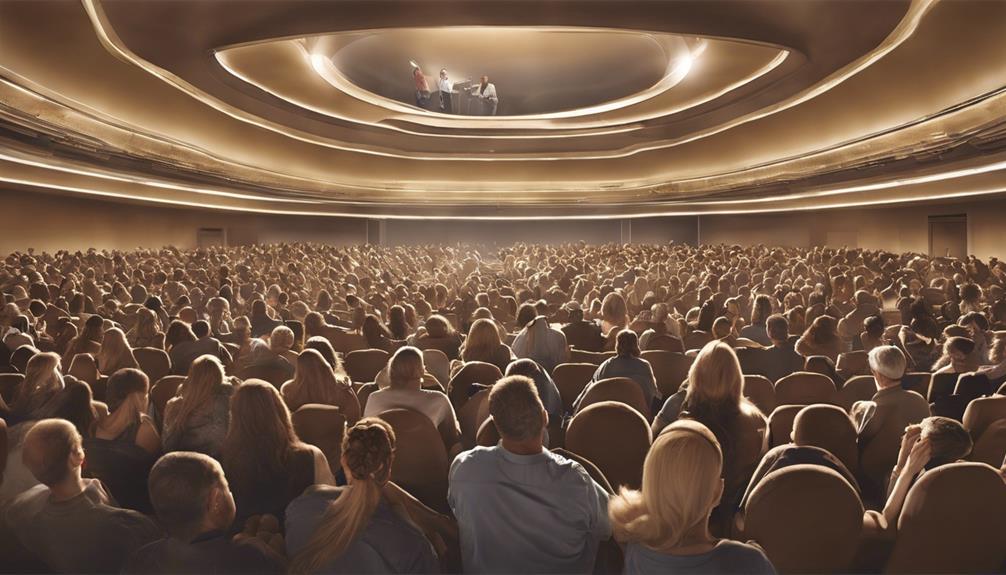
Hearing loop systems, comprised of copper wire encircling a room and linked to a sound system, play a crucial role in providing direct access to assistive listening systems for individuals with hearing impairments. These systems create an electromagnetic field that interacts with telecoils found in hearing aids and cochlear implants, allowing users to wirelessly receive audio signals from the hearing loop.
- Induction Loop Technology: Hearing loop systems use induction loop technology that transmits sound electromagnetically to telecoils in hearing devices.
- Direct Connection to Hearing Aids: Telecoils in hearing aids and cochlear implants pick up the audio signal directly from the hearing loop, enhancing the listening experience for individuals with hearing loss.
- Cost-Effective Solutions: Hearing loops offer a cost-effective way to improve accessibility in large public venues and private spaces, ensuring individuals with hearing impairments can participate fully.
- Efficient Access to Assistive Listening Systems: These systems provide efficient and direct access to assistive listening services, making communication clearer and more accessible for users.
FM Systems
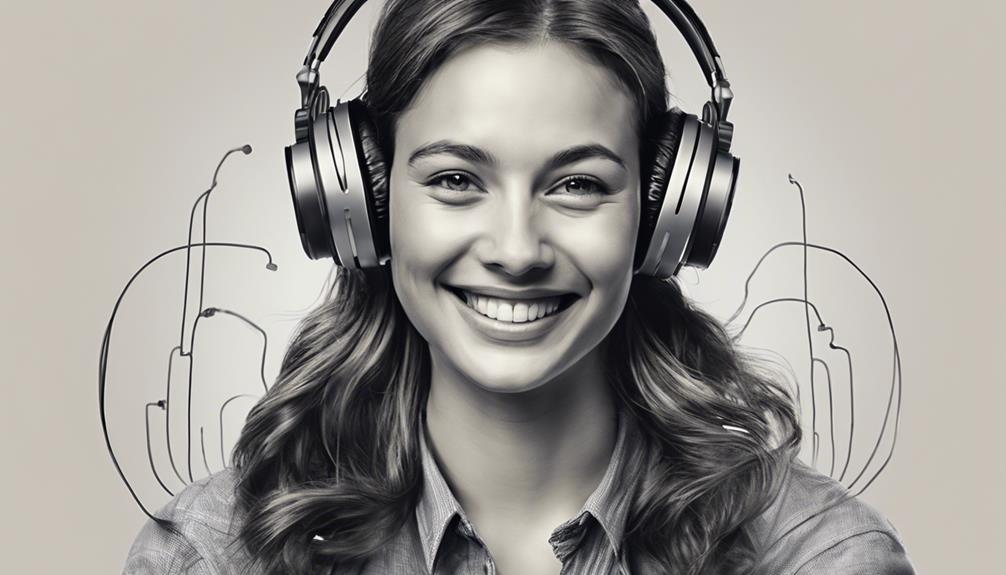
FM systems are versatile devices that transmit sound wirelessly using radio waves, ensuring clear reception in various settings. These systems are commonly utilized in group meetings, churches, and classrooms to enhance speech clarity for individuals with hearing loss.
Whether indoors or outdoors, FM systems offer improved sound amplification and can be used with or without hearing aids for maximum benefit.
FM System Basics
Utilizing radio waves for direct sound transmission to a listener's receiver, FM systems are widely employed in various settings such as classrooms, theaters, and group environments to enhance listening experiences. These systems offer several benefits:
- Enhanced Speech Clarity: FM systems help in reducing background noise interference, leading to clearer speech perception for the listener.
- Suitable for Hearing Loss: Particularly beneficial for individuals with hearing impairments, including those with cochlear implants.
- Portable Solution: FM technology provides a convenient and adaptable way to amplify sound tailored to individual needs.
- Versatile Applications: From educational settings to entertainment venues, FM systems cater to diverse environments requiring improved sound delivery.
Benefits of FM
Expanding on the advantages outlined, the practical benefits of FM systems in various settings are noteworthy. FM systems utilize radio waves to deliver sound directly to a receiver, ensuring clear and consistent sound quality. By reducing background noise, these systems enhance speech understanding, particularly beneficial in educational settings like classrooms and lecture halls. Individuals with hearing loss benefit significantly from FM systems, as they improve the ability to hear and comprehend spoken information effectively.
Moreover, FM systems can seamlessly integrate with hearing aids or cochlear implants, offering a comprehensive listening experience. In essence, FM technology plays a crucial role in mitigating communication barriers and enhancing auditory access for individuals with hearing impairments.
FM Usage Tips
When using FM systems for assistive listening, adjusting the receiver's volume to match your specific hearing requirements is key to optimizing your listening experience. Here are some tips for maximizing the benefits of FM systems:
- Reduce Background Noise: Position yourself in a way that minimizes interference from surrounding noises, allowing the FM system to deliver clear sound directly to your ears.
- Regularly Check Battery Levels: Ensure that the receiver has sufficient battery power to maintain a consistent audio level and prevent sudden disruptions.
- Utilize Integrated Technologies: Explore how FM systems can work in conjunction with other assistive listening devices to enhance your overall listening capabilities.
- Experiment with Volume Settings: Fine-tune the adjustable volume on your receiver to find the optimal level for improved speech understanding and enhanced listening comfort.
Infrared Systems
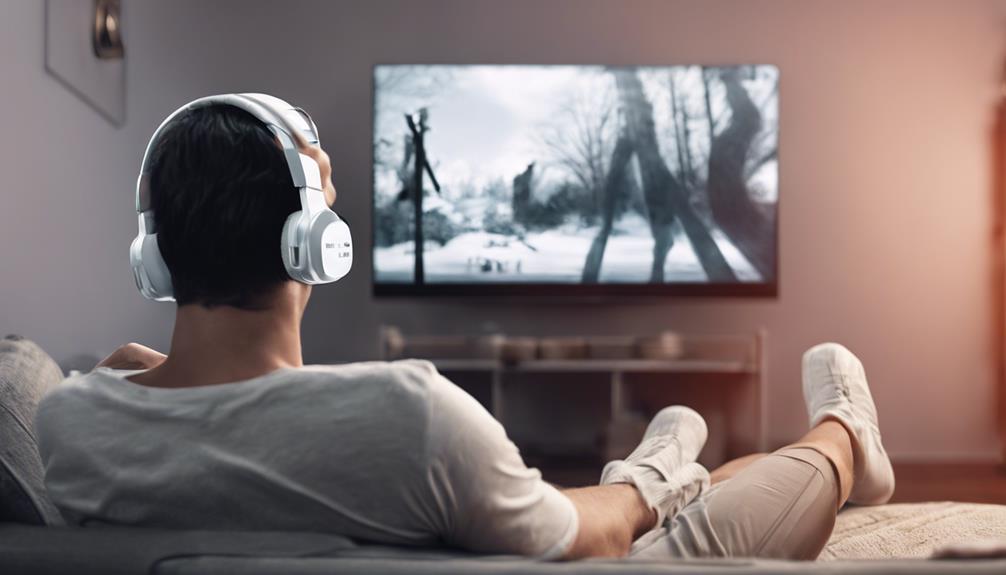
Infrared systems transmit sound wirelessly via invisible light beams, making them an excellent choice for indoor environments like churches and theaters. These systems are secure and interference-free, providing a reliable listening experience.
Infrared technology ensures privacy by confining the signal to the room, making it an ideal option for situations where confidentiality is important. Infrared devices are commonly used for TV listening in homes, offering individuals the opportunity to enjoy their favorite programs without disturbing others.
The advantage of using invisible light beams for transmission means that the signal is contained within the designated area, minimizing the risk of signal interception or leakage. This makes infrared systems a preferred choice for applications where confidentiality and privacy are paramount.
Whether you're in a crowded theater or enjoying a show at home, infrared systems provide a seamless listening experience that's both reliable and secure.
Telecoil or T-coil
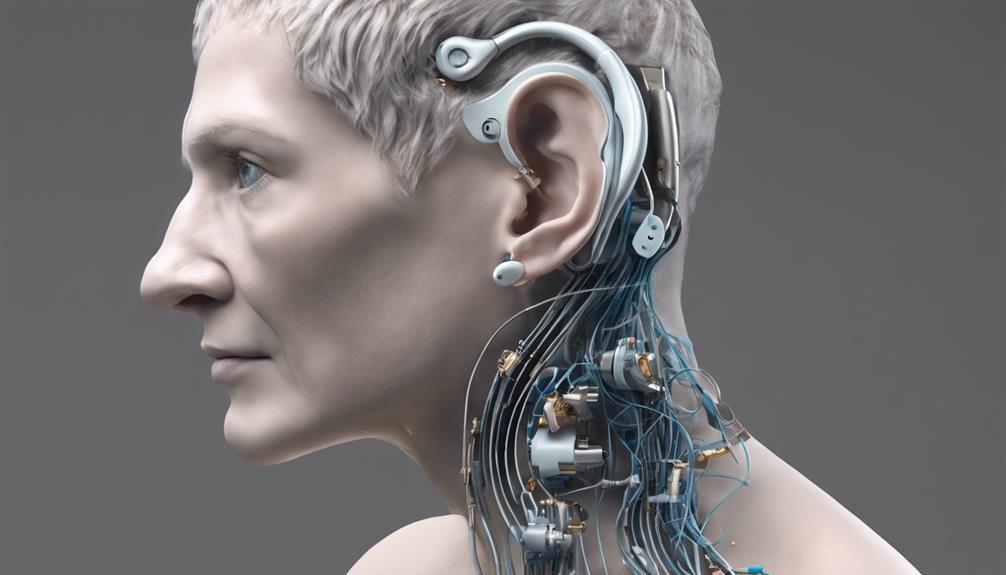
Moving from the discussion on Infrared Systems, the implementation of Telecoil or T-coil technology revolutionizes the accessibility and personalized listening experience for individuals with hearing loss. Telecoils, also known as T-coils, are small coils of wire integrated into hearing aids and cochlear implants. These coils capture electromagnetic signals produced by hearing loop systems, enabling the direct delivery of sound to the user's ear.
Here are four key points about telecoil technology:
- Essential Component: Telecoils are crucial for connecting individuals with hearing impairments to assistive listening systems while minimizing background noise interference.
- Seamless Switching: Users can easily transition between regular hearing aid mode and telecoil mode to access hearing loop systems in various environments.
- Personalized Experience: Telecoil technology allows for a tailored listening experience, catering to the specific needs and preferences of the user.
- Improved Accessibility: By leveraging electromagnetic signals, telecoils enhance accessibility by providing clearer sound transmission directly to the hearing device.
Assistive Devices for TVs
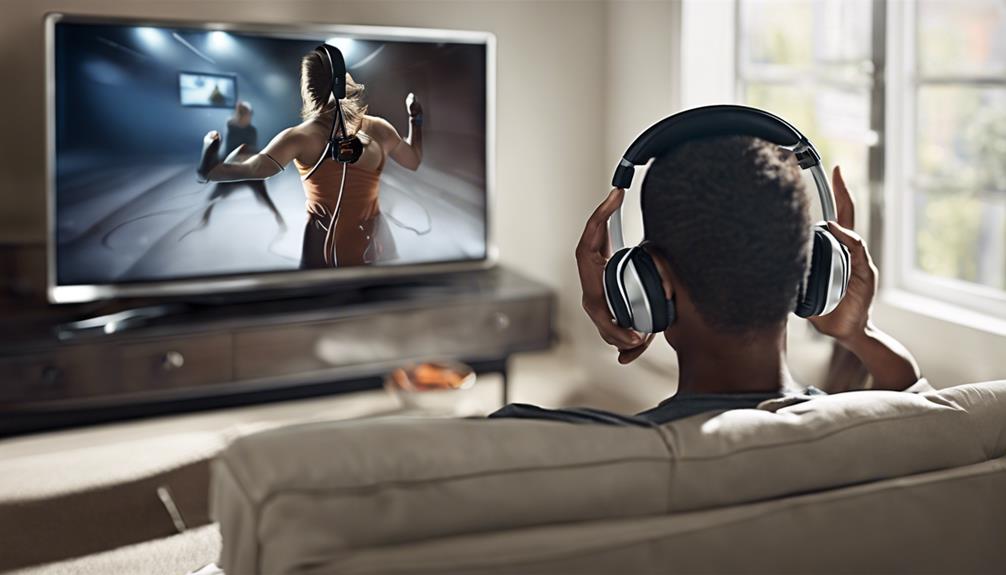
TV hearing devices, such as TV amplifiers and wireless TV headphones, offer individuals with hearing impairments the opportunity to enjoy television programs with enhanced sound quality.
Captioned phones with real-time captioning provide added support by displaying TV dialogue for improved comprehension.
Devices like TV Ears wireless headsets are designed to prevent sound distortion and ensure clear audio, making TV viewing more enjoyable for those with hearing loss.
TV Hearing Devices
When seeking enhanced audio clarity and personalized volume control for television viewing, individuals with hearing impairments often turn to TV hearing devices such as amplifiers and wireless headsets. These devices offer a range of benefits, including:
- Improved Sound Quality: TV amplifiers and wireless headsets provide clearer sound, reducing sound distortion often experienced by individuals with hearing loss.
- Independent Functionality: They work independently of hearing aids, enhancing the TV-watching experience without interfering with other devices.
- Wireless Connectivity: Popular options like TV Ears offer wireless connectivity, allowing users to move freely while watching TV.
- Personalized Volume Control: Users can adjust the volume to their preference, making it easier to hear dialogue and enjoy shows without disturbing others.
Wireless TV Headphones
Enhancing the television viewing experience for individuals with hearing impairments, wireless TV headphones provide clear sound directly to the user without disrupting others in the vicinity. These Wireless TV headphones use advanced technology to transmit audio from the TV to the headphones wirelessly, allowing users to enjoy personalized sound levels.
Especially beneficial for individuals with hearing loss, these devices amplify sound, making dialogues and background noises clearer. Users can easily adjust the volume levels to their comfort, enhancing their enjoyment and understanding of TV content.
With Wireless TV headphones, individuals can immerse themselves in their favorite shows or movies without missing out on important details, ensuring a more inclusive and engaging viewing experience.
Where to Buy ALDs
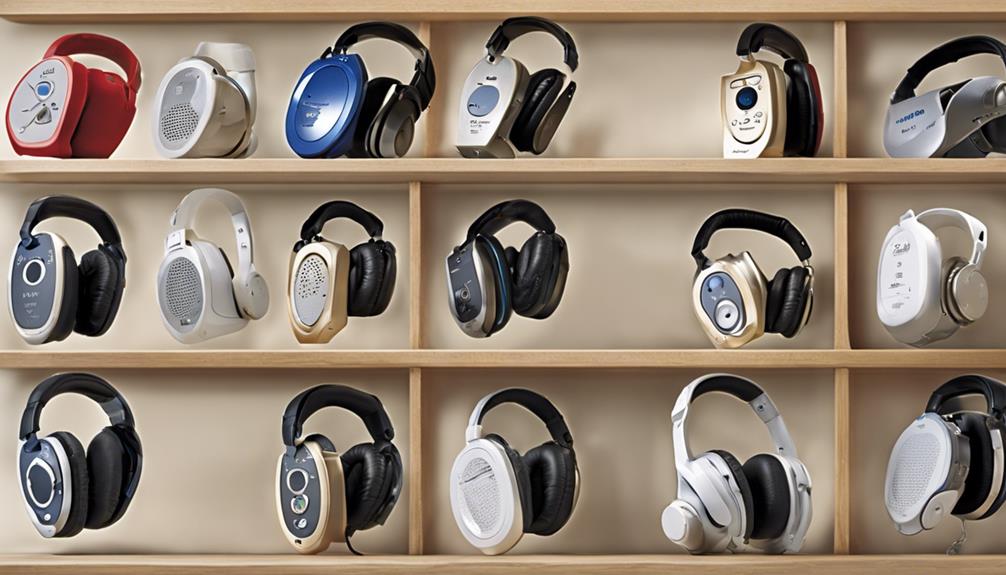
For individuals seeking to purchase Assistive Listening Devices (ALDs), exploring specialty retailers that offer a wide range of these devices is essential. When looking to buy ALDs, consider the following:
- Check Specialty Retailers: Look for stores that specialize in assistive listening devices as they'll likely have a diverse selection to choose from.
- Consult Vendor Lists: Utilize specific vendor lists that highlight retailers offering ALDs to streamline your search process.
- Utilize Online Searches: Conduct online searches for accessibility equipment to discover various retailers selling ALDs and compare options.
- Look for Discounts and Promotions: Keep an eye out for discounts, promotions, or financing options that different retailers may offer to make purchasing ALDs more affordable.
Frequently Asked Questions
How Does an Assistive Listening Device Work?
Assistive listening devices work by capturing sound with a microphone, then transmitting it wirelessly to a receiver worn by the user. The receiver converts the signal back into sound, amplifies it, and delivers it directly to the ear.
This process enhances speech clarity and comprehension, benefiting individuals with various degrees of hearing loss. By separating speech from background noise, these devices improve communication in settings like classrooms, theaters, and public venues.
What Are the Benefits of Assistive Listening Devices?
Benefits of assistive listening devices are vast. They revolutionize communication for those with hearing impairments.
ALDs boost reception of signals, enhancing comprehension in various settings. These devices foster clearer interactions in both personal and public spheres.
With targeted amplification, ALDs help navigate challenging listening conditions. They're indispensable tools for individuals seeking to engage fully despite hearing obstacles.
What Are the Examples of Assistive Listening Devices?
Sure, we can provide examples of assistive listening devices. These include:
- Audio induction or hearing loops
- FM systems
- Infrared systems
- Personal amplified systems
- Bluetooth systems
Each type serves specific needs, from eliminating background noise in large spaces to providing portable solutions for one-on-one conversations.
These devices cater to a range of environments, from churches and theaters to outdoor settings, offering clear reception and enhanced sound quality.
What Are the Benefits of the FM System?
The benefits of the FM system include clear sound reception by reducing background noise interference, making them ideal for various settings like churches and classrooms.
These systems enhance communication for individuals with hearing loss, integrating well with hearing aids and cochlear implants for improved listening experiences.
FM systems transmit sound wirelessly via radio waves, providing effective group meeting and class solutions.
Their versatility and adaptability make them essential tools for those seeking enhanced auditory support.
Conclusion
In conclusion, assistive listening devices serve as invaluable tools for individuals with hearing loss, providing clarity and enhancing communication in challenging environments.
Like a beacon of sound in a sea of noise, these devices bring important sounds closer to our ears, allowing us to navigate the waters of conversation with ease.
Whether it's a family gathering or a crowded event, ALDs are there to ensure that every voice is heard loud and clear.
-

 Navigating the VA System1 month ago
Navigating the VA System1 month agoVA Hearing Loss Rating Chart: Understanding Disability Compensation
-

 Therapies and Interventions3 days ago
Therapies and Interventions3 days ago10 Auditory Processing Goals for Effective Speech Therapy
-

 Vetted1 month ago
Vetted1 month ago15 Best Oticon Hearing Aids to Improve Your Hearing in 2024
-

 Sign Language22 hours ago
Sign Language22 hours agoMastering the Art of Signing Letters in Sign Language
-

 Navigating the VA System4 weeks ago
Navigating the VA System4 weeks agoUnderstanding Bilateral Hearing Loss VA Rating Criteria
-

 Tinnitus1 month ago
Tinnitus1 month agoVA's Rating System for Tinnitus and Hearing Loss Explained
-

 Sign Language6 days ago
Sign Language6 days agoSign Language Emoji Translator: How to Communicate With Gestures
-

 Sign Language2 months ago
Sign Language2 months agoMedical Sign Language PDF: A Comprehensive How-To Guide

















